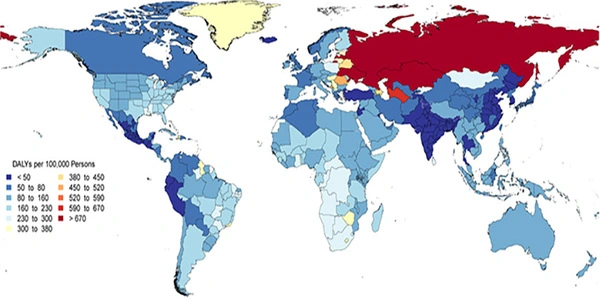According to a new Global Burden of Disease (GBD) special study released today in the Journal of the American College of Cardiology, a world without cardiovascular disease (CVD) is attainable, but millions of lives are lost prematurely to heart disease each year. The paper updates health estimates for the global, regional, and national burden of CVD and trends from 1990 to 2022 by assessing the effect of cardiovascular diseases and risk factors across 21 worldwide regions.
This study’s findings highlight the critical need for countries to adopt public health strategies focused on avoiding cardiovascular illnesses by emphasizing the global effort required to distribute knowledge and implement health initiatives, particularly in hard-to-reach countries. While cardiovascular disease rates are high worldwide, Asia, Europe, Africa, and the Middle East are expected to have the highest burden of CVD death. High blood pressure, high cholesterol, dietary hazards, and air pollution continue to be the top culprits.
“Cardiovascular diseases are a persistent challenge that lead to an enormous number of premature and preventable deaths,” said Gregory A. Roth, MD, MPH, senior author of the paper and associate professor in the Division of Cardiology and director of the Program in Cardiovascular Health Metrics at the Institute for Health Metrics and Evaluation at the University of Washington. “There are many inexpensive, effective treatments. We know what risk factors we need to identify and treat. There are simple healthy choices that people can make to improve their health. This atlas provides detailed information on where countries stand in their efforts to prevent and treat cardiovascular diseases.”
Cardiovascular diseases are a persistent challenge that leads to an enormous number of premature and preventable deaths. There are many inexpensive, effective treatments. We know what risk factors we need to identify and treat.
Gregory A. Roth
The mortality rates are broken down by place, as well as age, gender, and period. The report calculates disability-adjusted life years (DALYs), years lost due to premature death (YLLs), and years lived with disability (YLDs). Several changes to previously published estimates are included in the results, reflecting new data and disease modeling methodologies.
The paper focuses on 18 cardiovascular conditions and provides estimates for 15 major risk factors for cardiovascular disease: environmental (air pollution, household air pollution, lead exposure, low temperature, high temperature), metabolic (systolic blood pressure, LDL-C, body mass index, fasting plasma glucose, kidney dysfunction), and behavioral (dietary, smoking, secondhand smoke, alcohol use, physical activity).
“We formed the Global Burden of Cardiovascular Diseases Collaboration three years ago to help bring state-of-the-art research to the forefront of the global cardiovascular community,” said Valentin Fuster, MD, PhD, an author of the paper, President of Mount Sinai Fuster Heart Hospital, physician-in-chief of The Mount Sinai Hospital, and editor-in-chief of JACC. “We are excited to publish this 2023 Almanac as a dedicated issue of the Journal to inform the realities of CVD risk and inspire strategies for a heart-healthy world.”

Key takeaways from the report:
- Ischemic heart disease remains the leading cause of global CVD mortality with an age-standardized rate per 100,000 of 108.8 deaths, followed by intracerebral hemorrhage and ischemic stroke.
- High systolic blood pressure accounted for the largest contribution to attributable age-standardized CVD disability-adjusted life years (DALYs) at 2,564.9 per 100,000 globally.
- Dietary risks were the leading contributor to age-standardized CVD DALYs among the behavioral risks, while ambient particulate matter pollution led the environmental risks.
- Between 2015-2022, age-standardized CVD mortality increased in 27 out of 204 locations.
- Global death counts due to CVD increased from 12.4 million in 1990 to 19.8 million in 2022 reflecting global population growth and aging and the contributions from preventable metabolic, environmental, and behavioral risks.
- Eastern Europe had the highest age-standardized total CVD mortality at 553 deaths per 100,000. In contrast, countries in Australasia had the lowest age-standardized total CVD mortality at 122.5 deaths per 100,000 people.
- Central Asia, Eastern Europe, North Africa and the Middle East had the highest age-standardized mortality rate per 100,000 people attributable to high systolic blood pressure. The regions with the highest rates of CVD burden attributable to dietary risk were Central Asia, Oceania, and parts of North Africa and the Middle East.
“Identifying sustainable ways to work with communities to take action to prevent and control modifiable risk factors for heart disease is essential for reducing the global burden of heart disease,” said George A. Mensah, M.D., F.A.C.C., F.A.H.A., director of the Center for Translation Research and Implementation Science at the National Heart, Lung, and Blood Institute (NHLBI). “The 2023 Almanac represents an important resource for using locally relevant data to inform local-level actions for heart-healthy and thriving communities.”
The Global Burden of Cardiovascular Diseases Collaboration, which was launched in 2020, is a collaboration between the Journals of the American College of Cardiology, the University of Washington’s Institute for Health Metrics and Evaluation, and the National Heart, Lung, and Blood Institute. The 2023 report, which serves as an update to the GBD Study from 2022, includes data from 204 nations and territories, highlighting the major global modifiable cardiovascular risk factors, their contribution to disease burden, and current preventative breakthroughs.
















